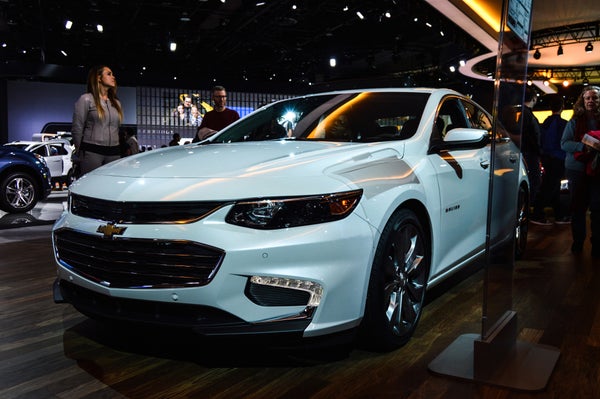A growing number of vehicles are meeting or surpassing federal fuel economy standards, though improvements to cars outpace those to trucks, according to a new analysis by the Consumer Federation of America.
The progress means automakers are on track to meet a federal target that doubles fuel efficiency in 2025 from 2012, according to the report.
“American consumers are enjoying a wide range of fuel-efficient cars in every single class,” said Jack Gillis, director of public affairs for CFA.
On supporting science journalism
If you're enjoying this article, consider supporting our award-winning journalism by subscribing. By purchasing a subscription you are helping to ensure the future of impactful stories about the discoveries and ideas shaping our world today.
The rules, set by U.S. EPA and the National Highway Traffic Safety Administration, require automakers to meet year-over-year hikes in fuel efficiency in different vehicle-size categories. The government will decide whether to change the standards after a lengthy review process starting this year, sparking considerable anticipation among carmakers. The industry has consistently met the standards since they began decades ago and were tightened by President Obama in 2012.
Because the rules set an average target, automakers can sell a mix of cars below and above the standard. For the third year in a row, more than half of the vehicles available had a window sticker rating of at least 23 mpg. The window sticker rating differs from the corporate average fuel economy (CAFE) rating, but that is about equivalent to this year’s requirement, according to the report.
“The good news is our analysis of current fuel economy across the U.S. fleet shows that manufacturers are complying with and exceeding CAFE requirements,” said Gillis.
CFA’s analysis tracked the fuel economy of the nearly 1,100 vehicles available on the market, not sales. The average window-sticker fuel economy of vehicles actually sold has hovered around 25.3 mpg since early 2014, with a slight dip late last year, according to the University of Michigan’s Transportation Research Institute.
Automakers “have introduced energy-efficient vehicles as fast as possible, so [they] are ahead in meeting government standards for now, but steeper targets lie ahead,” said trade group Alliance of Automobile Manufacturers.
A good way to judge whether that compliance will continue in the future is by looking at new models, said Gillis.
New models compliant for only some years to come
Based on their offerings at least, 15 out of the 16 major automakers he analyzed met or exceeded their 2015 fuel economy performance, a departure from last year’s backsliding (ClimateWire, May 26, 2015).
He pointed to a significant jump in the fuel efficiency of the 10 percent of the fleet that was “all-new,” so-called because manufacturers can incorporate their latest fuel-saving technology rather than having to tweak old models. Sixty-three percent of “all-new” 2016 vehicles were CAFE-compliant, compared to 41 percent last year.
“All-new” passenger cars—80 percent of which met their CAFE standards—drove that trend. The all-new Chevrolet Malibu lineup, for example, saw its fuel economy range jump from 24 to 29 mpg in 2015 to 28 to 46 mpg in 2016, thanks to new technologies like engine stop/start and a hybrid engine.
By contrast, the percentage of CAFE-compliant all-new light trucks and SUVs stayed the same at 40 percent.
That is significant because Americans are buying more trucks and SUVs than passenger cars amid collapsing oil prices. Last year, sales of light-duty trucks broke records, boosting overall vehicle sales to a record 17.5 million despite a decline in passenger car sales. That trend has continued into 2016.
Automakers have complained that consumer appetite for less fuel-efficient vehicles makes it harder for them to meet federal standards, but the CAFE requirements adjust automatically according to sales. Higher sales of trucks, however, do translate to less fuel and emissions savings overall.
Still, even the biggest gas guzzlers are improving their fuel efficiency, according to the CFA report. The below-16-mpg category declined from 6 percent in 2016 to 4 percent in 2016. The over-30-mpg category grew from 11.7 percent to 13 percent.
The most fuel-efficient cars are years ahead of schedule. Eighteen of the 19 “all-new” models that are CAFE compliant will remain so for at least two more years. Honda’s new Civic, one of the most popular internal-combustion engine cars in the United States, will remain compliant through 2023. The Chevrolet Volt, Chevrolet Spark (EV), Smart ForTwo (EV) and Toyota Prius all already meet the 2024 standards.
This year also marks the first time a non-electric vehicle company has met or exceeded fuel economy across its fleet. Every car made by Mazda Motor Corp. met its target, something only Tesla Motors Inc. had previously achieved.
Mitsubishi Motors Corp. also saw significant gains in its share of vehicles meeting or exceeding its target, up from 39 percent in 2015 to 79 percent. But that accolade comes with a big caveat. Last week, the Japanese carmaker admitted to having manipulated data to inflate the fuel efficiency of 625,000 vehicles sold in Asia.
“If companies are manipulating the tests, and other companies are revisiting their test results, that’s going to cast a pall over consumer attitude and trustworthiness of automakers," said Gillis.
A survey led by Mark Cooper, research director for CFA, showed that fuel economy is important to 80 percent of consumers, despite currently low gas prices. The same percentage also said that they support federal fuel economy standards. The numbers have stayed the same or increased slightly over the past decade.
Reprinted from Climatewire with permission from Environment & Energy Publishing, LLC. www.eenews.net, 202-628-6500
